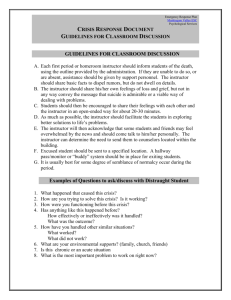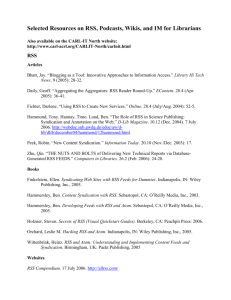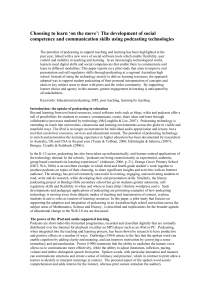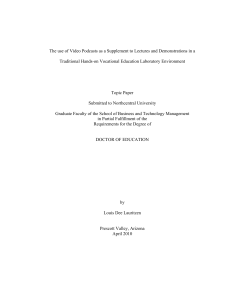Active Learning Handout (Download Doc)
advertisement
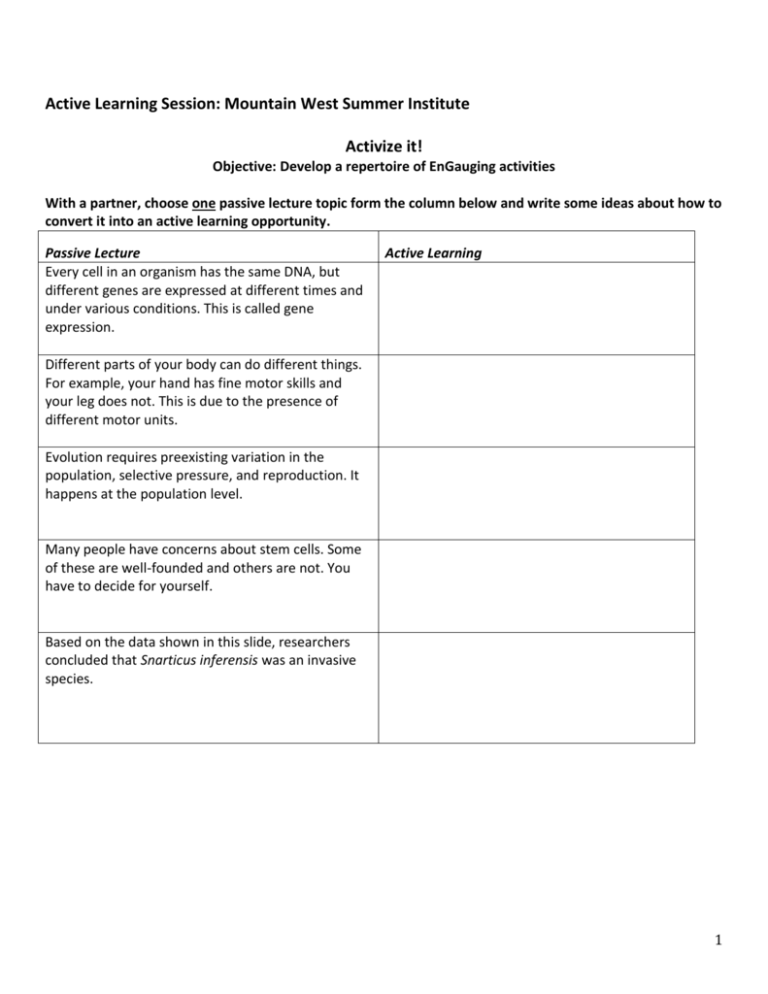
Active Learning Session: Mountain West Summer Institute Activize it! Objective: Develop a repertoire of EnGauging activities With a partner, choose one passive lecture topic form the column below and write some ideas about how to convert it into an active learning opportunity. Passive Lecture Every cell in an organism has the same DNA, but different genes are expressed at different times and under various conditions. This is called gene expression. Active Learning Different parts of your body can do different things. For example, your hand has fine motor skills and your leg does not. This is due to the presence of different motor units. Evolution requires preexisting variation in the population, selective pressure, and reproduction. It happens at the population level. Many people have concerns about stem cells. Some of these are well-founded and others are not. You have to decide for yourself. Based on the data shown in this slide, researchers concluded that Snarticus inferensis was an invasive species. 1 Summary of the BSCS 5E Instructional Model Objective 3: Identify strategies that are useful for implementation of active learning Phase Engagement Exploration Explanation Elaboration Evaluation Summary The teacher or a curriculum task accesses the learners’ prior knowledge and helps them become engaged in a new concept through the use of short activities that promote curiosity and elicit prior knowledge. The activity should make connections between past and present learning experiences, expose prior conceptions, and organize students’ thinking toward the learning outcomes of current activities. Exploration experiences provide students with a common base of activities within which current concepts (i.e., misconceptions), processes, and skills are identified and conceptual change is facilitated. Learners may complete lab activities that help them use prior knowledge to generate new ideas, explore questions and possibilities, and design and conduct a preliminary investigation. The explanation phase focuses students’ attention on a particular aspect of their engagement and exploration experiences and provides opportunities to demonstrate their conceptual understanding, process skills, or behaviors. This phase also provides opportunities for teachers to directly introduce a concept, process, or skill. Learners explain their understanding of the concept. An explanation from the teacher or the curriculum may guide them toward a deeper understanding, which is a critical part of this phase. Teachers challenge and extend students’ conceptual understanding and skills. Through new experiences, the students develop deeper and broader understanding, more information, and adequate skills. Students apply their understanding of the concept by conducting additional activities. The evaluation phase encourages students to assess their understanding and abilities and provides opportunities for teachers to evaluate student progress toward achieving the educational objectives. 2 Barriers to Active Learning Objective 4: Examine the reasons for student resistance to active learning and plan for addressing resistance Everyone in your group should select one slip of paper that describes a student barrier. Then fill out this table with underlying causes and strategies for overcoming the barrier. Share out. Student Barrier* Possible underlying cause Strategies for Overcoming this Barrier (choose from below or write your own) Potential Solution 1 – Instructor Immediacy Instructor immediacy involves students’ perception of the instructor as approachable and concerned about student success (e.g. making eye contact, learning names, moving around the classroom]. High levels of instructor immediacy have been positively correlated with student learning (Kearney et al., 1988; Kelley and Gorham, 1988). One study of the relationship between student resistance and instructor immediacy found that students were significantly more likely to comply with instructor requests from a moderate or highly immediate instructor than requests from a low-immediacy instructor (Burroughs, 2007). In addition, high instructor immediacy has been shown to correlate with student motivation to learn, as well as affective and cognitive learning (e.g. Titsworth, 2001; Witt and Wheeless, 2001). Potential Solution 2 – Explicit Discussion of Pedagogical Choices Help students understand why the teaching methods being used have been chosen. Some ways include sharing with students findings from studies about research on the efficacy of active learning, engaging students in reflecting on how they learn, and establishing expected student behaviors during class (Science Education Initiative, 2013). Potential Solution 3 – Structure student-student interactions to promote fairness The social loafing research literature offers three specific, research-based suggestions for maximizing positive student interactions in highly collaborative classrooms and decreasing incidents of social loafing: decrease group size, decrease project scope, and provide mechanisms for peer evaluation (Aggarwal and O’Brien, 2008; Brooks and Ammons, 2003). Potential Solution 4 – Give Students Mechanisms to Voice Concerns Before they Become Resistant Collecting systematic classroom evidence about student perspectives on the learning environment and student experiences within it is a simple way to gauge potential resistance and its sources. Examples include: (1) in-class anonymous clicker questions about if a particular assignment has been helpful for their learning; (2) minute papers that ask student to explain if they agree or disagree with the statement that the teaching approaches used in the class are improving their understanding of Biology; (3) online reflective journal in which they write about how a specific assignment supported their learning; and (4) Keep, Quit, Start cards in which students are asked to consider their learning in the course and propose one thing that the instructor should keep doing, one thing they should quit doing, and one thing they should start doing. Share the results with the class in a discussion. *Student resistance examples and potential solutions adapted from Seidel and Tanner, 2014. (complete list of references cited here are in Readings > Supplementary Readings > Active Learning Supplementary Readings) 3 Resources: Videos of Active Learning 1. Wendy Dustman – teaching Microbiology for Biology Majors using the flipped classroom model and collaborative student working groups http://podcasting.gcsu.edu/4DCGI/Podcasting/UGA/Episodes/26608/65996459.mov 2. Tessa Andrews – teaching introductory biology for non-science majors using a series of problem-based challenges related to sex determination http://podcasting.gcsu.edu/4DCGI/Podcasting/UGA/Episodes/12746/614158822.mov 3. Mara Evans – teaching ecology and competition in an introductory course for biology majors using a categorizing table http://podcasting.gcsu.edu/4DCGI/Podcasting/UGA/Episodes/5576/2962111.mov 4. Erin Dolan – introducing a peer review activity on vaccines for an introductory biology course for nonscience majors http://podcasting.gcsu.edu/4DCGI/Podcasting/UGA/Episodes/32309/15136614.mov 5. Erin Dolan –teaching regulation on energy transforming pathways for a Biochemistry course for biology majors using model building, clickers, and collaborative learning a. Start of session… http://podcasting.gcsu.edu/4DCGI/Podcasting/UGA/Episodes/22253/27757327.mov b. Biochemistry session continued… http://podcasting.gcsu.edu/4DCGI/Podcasting/UGA/Episodes/18074/4572359.mov c. Biochemistry session continued… http://podcasting.gcsu.edu/4DCGI/Podcasting/UGA/Episodes/12761/45486118.mov Additional Video Resources: iBiology Video Series http://www.ibiology.org/scientific-teaching/active-learning.html The iBiology Scientific Teaching Series project is a series of videos that provide current and future undergraduate biology instructors with the tools to design and implement a student-centered curriculum using evidence-based pedagogy. Class Notes Video Series Several University of North Carolina faculty members recognized for their skill at teaching large classes have generously shared their expertise in a series of video interviews, produced and curated by the Center for Teaching Excellence. This large and growing library of video clips features faculty from various departments discussing their general approach to teaching large enrollment courses and the specific instructional techniques they use. You can view these videos on CFE’s YouTube Channel, where they are organized into playlists by instructor and by instructional technique. http://www.youtube.com/user/UNCCFE/videos?view=1 Clicker Resources from Carl Wieman’s Science Teaching Initiative at the University of British Columbia: http://www.cwsei.ubc.ca/resources/clickers.htm 4




